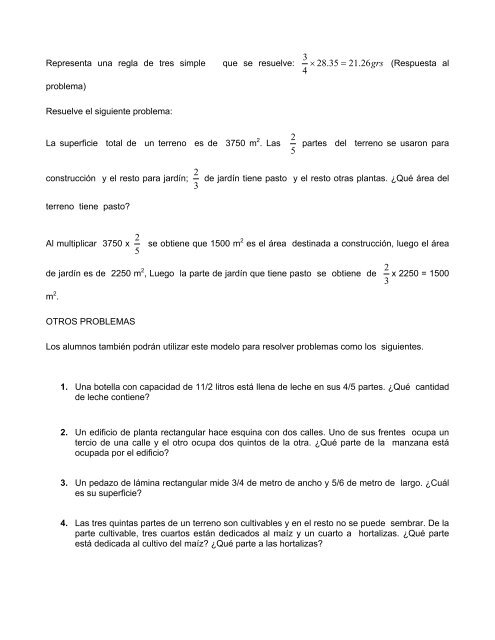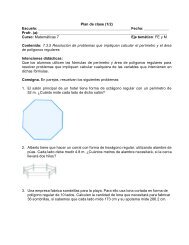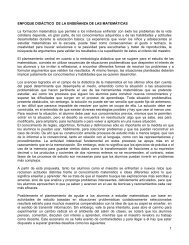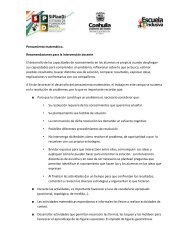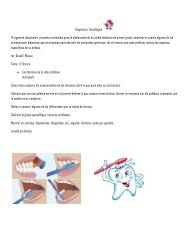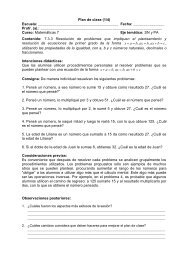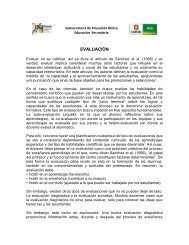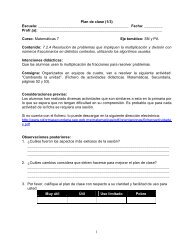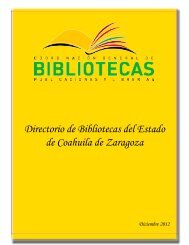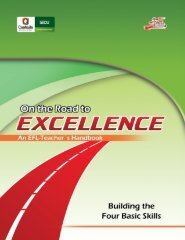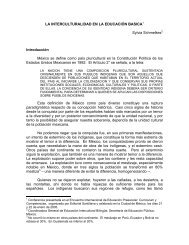eje: sentido numérico y pensamiento algebraico - Secretaría de ...
eje: sentido numérico y pensamiento algebraico - Secretaría de ...
eje: sentido numérico y pensamiento algebraico - Secretaría de ...
Create successful ePaper yourself
Turn your PDF publications into a flip-book with our unique Google optimized e-Paper software.
3<br />
Representa una regla <strong>de</strong> tres simple que se resuelve: × 28.<br />
35 = 21.<br />
26grs<br />
(Respuesta al<br />
4<br />
problema)<br />
Resuelve el siguiente problema:<br />
La superficie total <strong>de</strong> un terreno es <strong>de</strong> 3750 m 2 2<br />
. Las partes <strong>de</strong>l terreno se usaron para<br />
5<br />
2<br />
construcción y el resto para jardín; <strong>de</strong> jardín tiene pasto y el resto otras plantas. ¿Qué área <strong>de</strong>l<br />
3<br />
terreno tiene pasto?<br />
2 2<br />
Al multiplicar 3750 x se obtiene que 1500 m es el área <strong>de</strong>stinada a construcción, luego el área<br />
5<br />
<strong>de</strong> jardín es <strong>de</strong> 2250 m 2 2<br />
, Luego la parte <strong>de</strong> jardín que tiene pasto se obtiene <strong>de</strong> x 2250 = 1500<br />
3<br />
m 2 .<br />
OTROS PROBLEMAS<br />
Los alumnos también podrán utilizar este mo<strong>de</strong>lo para resolver problemas como los siguientes.<br />
1. Una botella con capacidad <strong>de</strong> 11/2 litros está llena <strong>de</strong> leche en sus 4/5 partes. ¿Qué cantidad<br />
<strong>de</strong> leche contiene?<br />
2. Un edificio <strong>de</strong> planta rectangular hace esquina con dos calles. Uno <strong>de</strong> sus frentes ocupa un<br />
tercio <strong>de</strong> una calle y el otro ocupa dos quintos <strong>de</strong> la otra. ¿Qué parte <strong>de</strong> la manzana está<br />
ocupada por el edificio?<br />
3. Un pedazo <strong>de</strong> lámina rectangular mi<strong>de</strong> 3/4 <strong>de</strong> metro <strong>de</strong> ancho y 5/6 <strong>de</strong> metro <strong>de</strong> largo. ¿Cuál<br />
es su superficie?<br />
4. Las tres quintas partes <strong>de</strong> un terreno son cultivables y en el resto no se pue<strong>de</strong> sembrar. De la<br />
parte cultivable, tres cuartos están <strong>de</strong>dicados al maíz y un cuarto a hortalizas. ¿Qué parte<br />
está <strong>de</strong>dicada al cultivo <strong>de</strong>l maíz? ¿Qué parte a las hortalizas?


